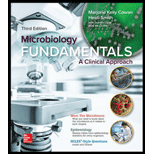
Concept explainers
To determine:
The reasons for the similarities between bacteria and eukaryotic cells that are radically different organisms.
Introduction:
Bacteria are prokaryotes, which have no organelles. They are single-celled organisms. Their cell wall has peptidoglycan and they reproduce by binary fission. The bacteria included in prokaryotes, are unicellular organisms without a nucleus and their chromosomes are condensed in the cytoplasm. They contain ribosomes of 70S type.
Eukaryotes can be distinguished from other organisms, because they contain a eukaryotic cell with true nucleus. There are limited numbers of sources of carbon and energy that are able for eukaryotes and they can reproduce sexually. Evolution would be occur in eukaryotes intheir gene regulation patterns, cell shape, and cell types that can further interact for their growth and development.
Want to see the full answer?
Check out a sample textbook solution
Chapter 3 Solutions
Microbiology Fundamentals: A Clinical Approach
- There are three main ways that bacteria and archaea are essential to eukaryotic life. Explain the three different ways and give at least one example of each.arrow_forwardYou a clinical lab worker. Your boss hands you a sample and asks you to identify the genus of bacteria in the sample. Using a microscope, you see long chains spherical bacteria, indicative of repeated divisions along one plane. To what genus do you think bacterial sample belongs? (Choose all that apply.) Group of answer choices Lactobacillus Lactococcus Staphylococcus Streptococcus Caulobacterarrow_forwardArchaea (formerly known as archaebacteria) is one of the three major divisions of living organisms; the other two are eubacteria and eukaryotes. Nanoarchaeum equitans is in the Archaea domain and has one of the smallest genomes known, about 0.5 Mb. How can an organism complete its life cycle with so little genetic material?arrow_forward
- What do you mean by domain bacteria? Explain it briefly.arrow_forwardWhich of the following is a possible characteristic of prokaryotic and eukaryotic cells? O peptidoglycan O linear DNA O pseudomurein O photosynthetic membrane system O plasmidsarrow_forwardArchaea are different from Eubacteria are different types of prokaryotes because... Archaea lack a nucleus Archaea are unicellular Archaea lack peptidoglycan in their cell wall Archaea do not have ribosomesarrow_forward
- Microbiologists have announced the discovery of over 30 new species of bacteria that thrive between the teeth and gums of humans. The bacteria could not be grown in the researcher's laboratories, nor were any of them ever observed via and kind of microscopy. If they couldn't culture them or see them, how could the researchers know they discovered a new species? If they couldn't examine the cells for the presence of a nucleus, how did they determine that the organisms were prokaryotes and not eukaryotes?arrow_forwardAll of the following are correctly matched and can be found in bacteria EXCEPT: O Cell wall - contains peptidoglycan Ribosomes - site of protein synthesis Nucleus - membrane-bound organelle containing multiple chromosomes Cell (plasma) membrane - encloses cytoplasm; phospholipid bilayer with proteins O None of the other four answers (all are correctly matched and can be found in bacteria)arrow_forwardBacteria and Archaea are sometimes termed nature’s master chemists. Why is this a more apt description for members of the Prokaryotic tree of life than the branch of Eukaryotic life?arrow_forward
- What are the flaws ? Prokaryotes can live in many different environments. Anerobic organisms need oxygen to survive, while aerobic organisms can survive without oxygen. Autotrophs are organisms that can assemble high energy macromolecules for their energy. Chemotrophs are organisms that capture energy from light. Extremophiles are organisms that grow in extreme conditions like boiling water. Gram-positive bacteria have few layers of peptidoglycan, while gram-negative bacteria have many layers of peptidoglycan and are surrounded by an outer membrane. Harmful bacteria can cause illness like food poisoning. Helpful bacteria can be used in food production to make yogurt. The endosymbiotic theory states that some of the organelles in eukaryotes were once free living prokaryotes. This is supported by the mitochondria and cytoplasm since they have their own DNA and ribosomes. Harmful protists can cause diseases like malaria in humans and downy mildew in plants. Helpful protists can be…arrow_forwardWhat are 5 cellular parts that are specific to ALL bacteria. This should not include any cellular parts listed above (like cytoplasm) that both prokaryotes and eukaryotes will have. This also should not include cellular parts that only specific types of bacteria will have (example: flagella). Then state the function of the cellular part (what does it do for the cell?)arrow_forwardThe famous scientist Louis Pasteur incorrectly assumed that the process of fermentation was a biological process, not one that was possible using ordinary chemistry. Of course, he was mistaken. One form of protein bridged the biological/chemical divide, allowing processes to take place both within and outside of cells. What are these proteins called, and how do they allow Pasteur to do what he thought was impossible?arrow_forward
 Human Anatomy & Physiology (11th Edition)BiologyISBN:9780134580999Author:Elaine N. Marieb, Katja N. HoehnPublisher:PEARSON
Human Anatomy & Physiology (11th Edition)BiologyISBN:9780134580999Author:Elaine N. Marieb, Katja N. HoehnPublisher:PEARSON Biology 2eBiologyISBN:9781947172517Author:Matthew Douglas, Jung Choi, Mary Ann ClarkPublisher:OpenStax
Biology 2eBiologyISBN:9781947172517Author:Matthew Douglas, Jung Choi, Mary Ann ClarkPublisher:OpenStax Anatomy & PhysiologyBiologyISBN:9781259398629Author:McKinley, Michael P., O'loughlin, Valerie Dean, Bidle, Theresa StouterPublisher:Mcgraw Hill Education,
Anatomy & PhysiologyBiologyISBN:9781259398629Author:McKinley, Michael P., O'loughlin, Valerie Dean, Bidle, Theresa StouterPublisher:Mcgraw Hill Education, Molecular Biology of the Cell (Sixth Edition)BiologyISBN:9780815344322Author:Bruce Alberts, Alexander D. Johnson, Julian Lewis, David Morgan, Martin Raff, Keith Roberts, Peter WalterPublisher:W. W. Norton & Company
Molecular Biology of the Cell (Sixth Edition)BiologyISBN:9780815344322Author:Bruce Alberts, Alexander D. Johnson, Julian Lewis, David Morgan, Martin Raff, Keith Roberts, Peter WalterPublisher:W. W. Norton & Company Laboratory Manual For Human Anatomy & PhysiologyBiologyISBN:9781260159363Author:Martin, Terry R., Prentice-craver, CynthiaPublisher:McGraw-Hill Publishing Co.
Laboratory Manual For Human Anatomy & PhysiologyBiologyISBN:9781260159363Author:Martin, Terry R., Prentice-craver, CynthiaPublisher:McGraw-Hill Publishing Co. Inquiry Into Life (16th Edition)BiologyISBN:9781260231700Author:Sylvia S. Mader, Michael WindelspechtPublisher:McGraw Hill Education
Inquiry Into Life (16th Edition)BiologyISBN:9781260231700Author:Sylvia S. Mader, Michael WindelspechtPublisher:McGraw Hill Education





